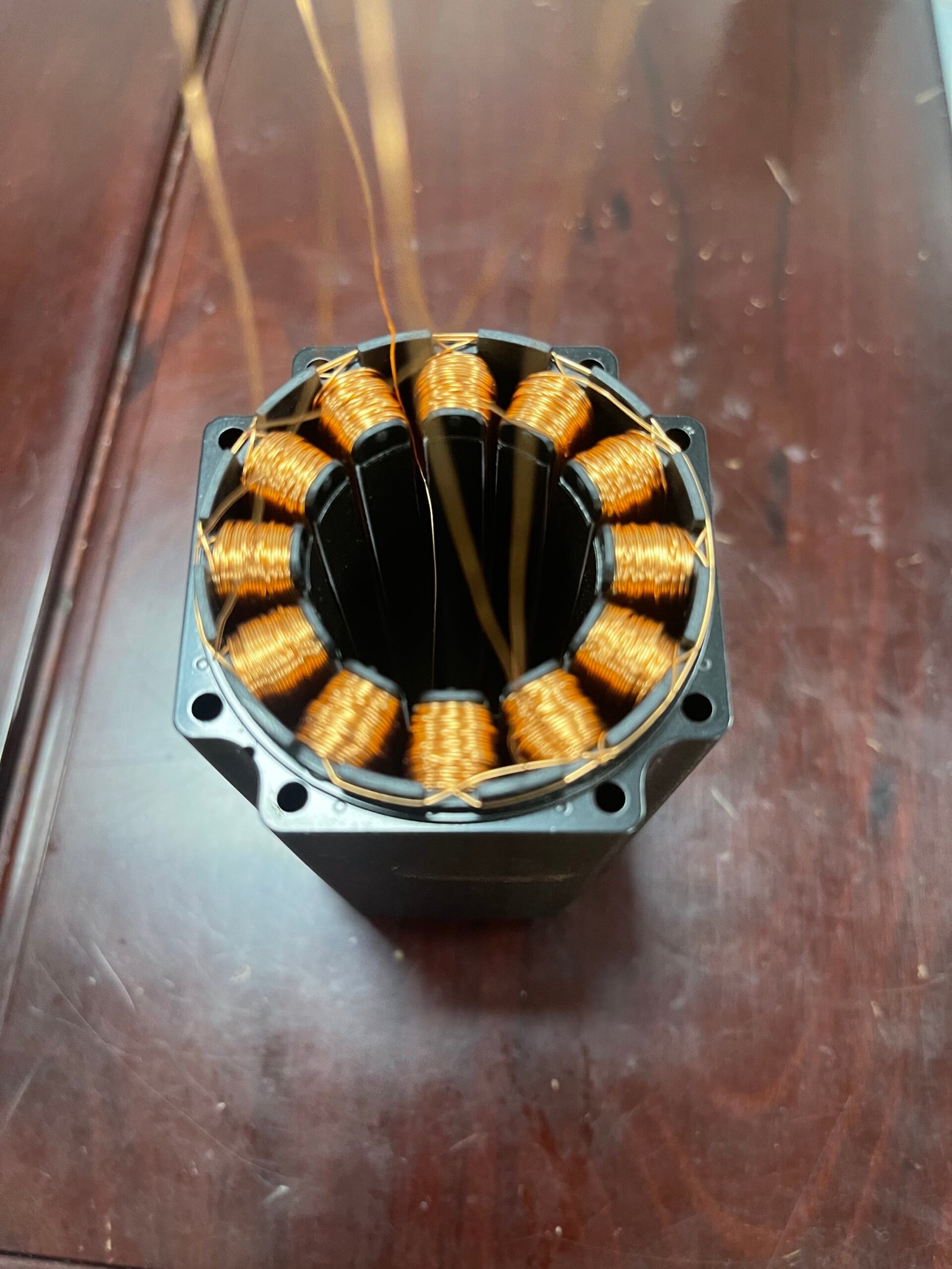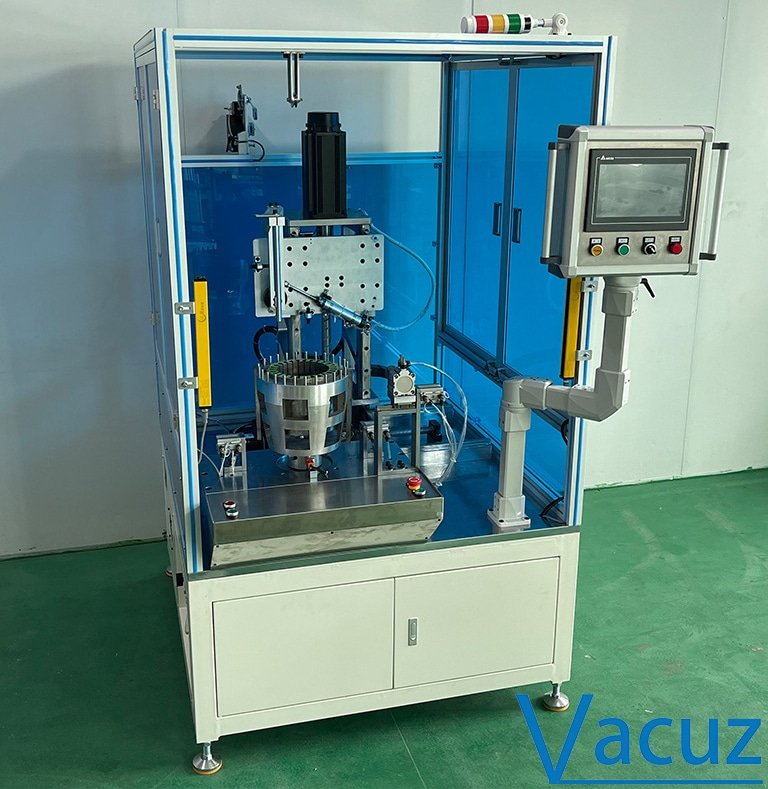For a fully automatic high-speed stator winding machine to operate stably, in addition to the hardware configuration, it also places high demands on the stator and mold. So, what are these requirements for a fully automatic high-speed winding machine? How can high-speed and stable operation be achieved? Vacuz will explain.

Vacuz Automatic Inner BLDC Air Conditioner Motor Stator Core Needle/Fly Fork Winding Machine Packaging
I. Core Requirements for the Stator
1. Dimensional Compatibility
The stator’s outer and inner diameters must strictly match the winding machine model. For brushless micro-winding equipment, for example, the stator’s outer diameter is typically required to be between 20 and 130 mm, and its inner diameter between 12 and 100 mm. If the stator dimensions exceed this range, custom equipment will be required. Furthermore, the stator stack height (height) is generally controlled between 5 and 80 mm. Excessive stack height can make needle swing and thread feeding difficult. Optimizing thread feeding methods (such as using curved thread feeding grooves or increasing the number of guide rollers) is necessary to prevent thread scraping, damage, or breakage.
2. Slot Orientation and Structure
Slot Orientation: The stator slot orientation directly determines the type of winding machine. Stators with inward-facing slots require an internal winding machine (such as a precision internal winding machine), while stators with outward-facing slots are suitable for external winding machines.
Slot Design: The slot shape must match the winding path algorithm to prevent wire scratches. For example, the needle bar motion trajectory should be adjusted for different slot shapes (such as rectangular slots and trapezoidal slots) to ensure smooth wire entry. Additionally, the slot edges should be chamfered to reduce friction between the wire and the slot.
3. Parameter Consistency
Accurate stator parameters (such as outer diameter, inner diameter, height, slot orientation, slot spacing, enameled wire diameter, number of turns, and number of slots) must be provided as the basis for winding machine selection and commissioning. Inconsistent parameters can lead to problems such as wire breakage and uneven coils during winding.
II. Core Requirements for Molds
1. Processing Accuracy
Tolerance Control: Mold manufacturing must strictly follow the process drawings, and the tolerances of each component must meet customer requirements. For example, the mold aperture must precisely match the stator size to avoid looseness or insufficient tightening.
Surface Treatment: The mold surface must be polished to ensure smooth curved and concave surfaces, free of burrs and burrs, to prevent scratching of the enameled wire. The polished mold surface roughness should be Ra 0.8μm or less.
2. Structural Compatibility
Model Matching: The mold must be compatible with the winding machine model and stator structure. For example, the mold for an internal winding machine must fit tightly with the needle bar or flyer fork to ensure no wobble during the winding process.
Optimized Design: Optimize the mold design for the wire feeding, dwelling, and winding stages to streamline the process and improve winding efficiency. For example, guide grooves can be added to the mold to guide the wire smoothly into the slot.
3. Tightening and Stability
The mold must remain secure during the winding process to prevent loosening that could cause winding misalignment or damage. Regularly check the mold tightening status to ensure long-term stability. For example, high-strength bolts and lock washers are used to secure the mold, and the bolt preload should be regularly checked.
III. Key Measures for Achieving High-Speed and Stable Operation
1. Equipment Configuration Optimization
Servo Control System: Select high-precision servo motors (such as Panasonic, Fuji, and Delta series) that support multi-axis interpolation motion to achieve precise control of winding trajectory, angle, and speed. For example, winding speeds can reach 800-1000 RPM while ensuring precise and neat wire routing.
Tension Control: A real-time tension monitoring system is deployed. Tension sensor data is fed back to the control system, automatically adjusting the tension value to prevent wire breakage or damage caused by tension fluctuations. For example, a closed-loop tension control system can achieve tension control accuracy of ±0.1N.
High-Speed Accessories: Select high-speed motors, high-precision bearings, and lightweight needle bars to reduce inertial shock and improve equipment response speed. For example, ceramic bearings are used to reduce friction and wear.
2. Process Parameter Optimization
Wire Diameter Adaptation: The tensioner range is adjusted according to the diameter of the enameled wire. For example, 0.1mm thin wire requires low tension (≤0.5N) to avoid stretching and deformation, while 1.0mm thick wire requires high tension to ensure a tight coil.
Speed and Load Balance: Match the winding speed with the equipment’s load capacity. For example, a lightweight design can reduce inertial shock, enabling high-speed operation (>800 RPM) while maintaining stability.
Wire Arrangement Accuracy: Use a laser rangefinder to measure wire spacing, ensuring tolerances are within the permitted range (e.g., ±0.05mm), improving winding consistency.
3. Environmental and Maintenance Control
Temperature and Humidity Management: Maintain a workshop temperature between 20°C and 30°C, with a relative humidity below 60%, to prevent overheating of electronic components and short circuits on circuit boards. For example, use air conditioners and dehumidifiers to control environmental conditions.
Vibration Mitigation: Secure the equipment on an anti-vibration platform to minimize the impact of vibration on winding accuracy. For example, an accelerometer can monitor vibration frequency to detect potential faults in advance.
Preventive Maintenance: Regularly clean equipment surfaces of dust and add lubricant to reduce wear; record winding parameters and fault codes, and optimize processes through big data analysis. For example, establish equipment maintenance records to record the time and content of each maintenance session.
4. Operating Standards and Training
Standardized Processes: Develop detailed SOPs (Standard Operating Procedures) for changeovers, commissioning, and maintenance to ensure consistent operations. For example, commissioning should be performed in stages:
Manual Mode: Adjust the relative positions of the needle bar, nozzle, and stator slot to ensure alignment accuracy.
Low-Speed Start: Observe that the wire enters the slot smoothly, without skipping or jamming.
Gradual Speed Increase: Monitor tension fluctuations and adjust PID parameters to ensure a tight and continuous wire feed.
Skill Assessment: Regularly conduct fault simulation drills with operators to improve emergency response capabilities and reduce downtime. For example, simulate faults such as wire breakage and abnormal tension to assess the operator’s emergency response capabilities.

Подгонянный увеличенный размер одиночной станции Vacuz Servo автоматического BLDC безщеточного внутреннего двигателя статора катушки намотки иглы машинное оборудование
What are the requirements for the stator and mold of a fully automatic high-speed winding machine? How can high-speed and stable operation be achieved? Vacuz has provided simple instructions, and we hope these tips can help you!
Электронная почта: sales@vacuz.com





